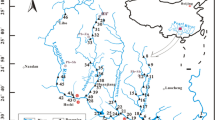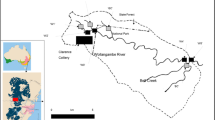Abstract
The analysis of heavy metals in sediments, associated with geochronology, can identify the historical accumulation of these contaminants that occurred over time as a result of anthropogenic activities. A study was conducted at Paiva Castro Reservoir, a tropical reservoir in Brazil, to (1) establish baseline values for the metals Cd, Cr, Cu, Ni, Pb, Zn, Mn, Al and Fe; (2) investigate the history of heavy metal accumulation through geochronology using 210Pb; and (3) identify the main variables that differentiate the sampled regions. A gravity corer was released twice in three reservoir areas. Each core was sliced at intervals of 2 cm and stored in a sealed plastic bag. One core was used for the determination of metals and for dating using the 210Pb technique. The other core was used for the determination of organic matter and particle size. The baseline values for heavy metals were calculated according to the mean bottommost samples of the three core analysed. In terms of the levels of heavy metals, the greatest impacts in the region occurred during periods prior to the period of reservoir operation. In surface sediments, Cu exceeded several times (97.0 mg kg−1) the background (24.0 mg kg−1). This result may be a consequence of the application of copper sulphate for controlling algal blooms. A canonical discriminant analysis indicated that the variables that significantly differentiated the three sampled areas were related to the elements Al, Fe, and Mn and to particle size. These data indicate that the main differences are due to lithological variations and to the dynamic operation of reservoirs that provide a larger particle size fraction in the area where the uptake of water for the public water supply is located and in the area upstream from Paiva Castro, where there is higher flow energy. Evidence of the degradation of Paiva Castro Reservoir is already being reflected in the sediments. It is necessary that public policies are actually applied to counteract the degradation of this important ecosystem; otherwise, the reservoir’s ‘good quality’ will be at risk.














Similar content being viewed by others
References
Allaby M (2008) Oxford dictionary of earth sciences, 3rd edn. Oxford University Press, Oxford
Andersen JH, Conley DJ, Hedal S (2004) Palaeoecology, reference conditions and classification of ecological status: the EU water framework directive in practice. Mar Pollut Bull 49:283–290
Arnason JG, Fletcher BA (2003) A 40+ year record of Cd, Hg, Pb, and U deposition in sediments of Patroon Reservoir, Albany County, NY, USA. Environ Pollut 123:383–391
Bennion H, Battarbee R (2007) The European Union water framework directive: opportunities for palaeolimnology. J Paleolimnol 38:285–295
Chalmers AT, Van Metre PC, Callender E (2007) The chemical response of particle-associated contaminants in aquatic sediments to urbanization in New England, USA. J Contam Hydrol 91:4–25
Chapman PM, Wang F, Adams WJ, Green A (1999) Appropriate applications of sediment quality values for metals and metalloids. Environ Sci Technol 33(22):3937–3941
Devesa-Rey R, Díaz-Fierros F, Barral MT (2011) Assessment of enrichment factors and grain size influence on the metal distribution in riverbed sediments (Anllóns River, NW Spain). Environ Monit Assess 179:371–388
Din ZB (1992) Use of aluminium to normalize heavy-metal data from estuarine and coastal sediments of Straits of Melaka. Mar Pollut Bull 24(10):484–491
EMPLASA (2006) Empresa Metropolitana de Planejamento da Grande São Paulo. Metrópoles em dados. Emplasa, São Paulo
Esteves FA (2011) Limnologia. INEP, Interciência, Rio de Janeiro
Fávaro DIT, Damatto SR, Moreira EG, Mazzilli BP, Campagnoli F (2007) Chemical characterization and recent sedimentation rates in sediment cores from Rio Grande reservoir, SP, Brazil. J Radioanal Nucl Chem 273(2):451–463
Figueira RCL (2000) Inventário de radionuclídeos artificiais em água do mar e sedimentos da costa sul do Brasil. Doctoral thesis. Instituto de Pesquisas Energéticas e Nucleares
Figueira RCL, Tessler MG, Mahiques MM, Fukumoto MM (2007) Is there a technique for the determination of sedimentation rates based on calcium carbonate content? A comparative study on the Southeastern Brazilian shelf. Soils Found 47:649–656
Förstner U, Wittmann GTW (1981) Metal pollution in the aquatic environment. Springer, New York
Galbreath-O’leary B (2009) A call to ban copper sulfate (an algaecide) for use in America’s waters. http://www.articlesbase.com/gardening-articles/protecting-national-water-resources-a-call-to-ban-copper-sulfate-for-use-in-americas-ponds-and-lakes-1023238.html. Accessed 30 Jan 2013
Hammer Ø, Harper DAT, Ryan PD (2001) PAST: paleontological statistics software package for education and data analysis. Palaeontol Electron 4(1):9. http://palaeo-electronica.org/2001_1/past/issue1_01.htm
Hanson MJ, Stefan HG (1984) Side effects of copper sulfate treatment of the Fairmont Lakes, Minnesota. Water Resour Bull 20(6):889–899
Hawkins PR, Griffiths DJ (1987) Copper as an algicide in a tropical reservoir. Water Res 21(4):475–480
He J, Lu C, Fan Q, Xue H, Bao J (2011) Distribution of AVS-SEM, transformation mechanism and risk assessment of heavy metals in the Nanhai Lake in China. Environ Earth Sci 64:2025–2037
Hernández RB, Oliveira E, Espósito BP (2009) Distribution and behavior of manganese in the Alto do Paranapanema Basin. J Environ Monit 11:1236–1243
Huertos EG, Baena AR (2008) Contaminacion de solos por metales pesados. Macla 10:48–60
Kelly M, Juggins S, Guthrie R, Pritchard S, Jamieson J, Rippey B, Hirst H, Yallop M (2008) Assessment of ecological status in U.K. rivers using diatoms. Freshw Biol 53:403–422
Lokeshwari H, Chandrappa GT (2007) Effects of heavy metal contamination from anthropogenic sources on Dasarahalli tank, India. Lake Reserv Manag 12:121–128
Luoma SN, Rainbow PS (2008) Metal contamination in aquatic environments: science and lateral management. Cambridge University, Cambridge
Macedo CCL (2011) Heterogeneidade espacial e temporal das águas superficiais e das macrófitas aquáticas do reservatório Paiva Castro (Mairiporã-SP-Brasil). Dissertation, Universidade Estadual Paulista-UNESP
Mariani CF, Pompêo MLM (2008) Potentially bioavailability metals in sediment from a tropical polymictic environment Rio Grande Reservoir, Brazil. J Soils Sediments 8:284–288
Meguro M (2000) Métodos em Ecologia. São Paulo. Apostila de Metodologias para a disciplina BIE—321 Ecologia Vegetal. Instituto de Biociências-USP, São Paulo
Michelutti N, Simonetti A, Briner JP, Funder S, Creaser RA, Wolfe AP (2009) Temporal trends of pollution Pb and other metals in east-central Baffin Island inferred from lake sediment geochemistry. Sci Total Environ 407:5653–5662
Moreira SRD, Fávaro DIT, Campagnoli F, Mazzili BP (2002) Sedimentations from the reservoir Rio Grande (São Paulo/Brasil). In: Warwick P (ed) Environmental radiochemical analysis II. Royal Society of Chemistry, Maidstone, pp 383–390
Nascimento MRL, Mozeto A (2008) Reference values for metals and metalloids concentration in bottom sediments of Tietê river basin, southeast of Brasil. Soil Sediment Contam 17(3):269–278
Pienitz R, Roberge K, Vincent WF (2006) Three hundred years of human-induced change in an urban lake: paleolimnological analysis of Lac Saint-Augustin, Québec City, Canada. Can J Bot 84:303–320
Piper CS (1947) Soil and Plant Analysis. Interscience publishers, New York
PMM-Prefeitura Municipal de Mairiporã (2012) Plano municipal de saneamento básico de Mairiporã Vol I Plano Municipal dos Sistemas de Abastecimento de Água e de Esgotamento Sanitário. PMM, Mairiporã
Pompêo MLM, Padial PR, Mariani CF, Cardoso-Silva S, Moschini-Carlos V, Silva DCVR, Paiva TCB, Brandimarte AL (2013) Biodisponibilidade de metais no sedimento de um reservatório tropical urbano (reservatório Guarapiranga—São Paulo (SP), Brasil): há toxicidade potencial e heterogeneidade espacial? Geochim Bras 27(2):104–119
Räsänen J, Kauppila T, Salonen VP (2006) Sediment-based investigation of naturally or historically eutrophic lakes—implications for lake management. J Environ Manage 79:253–265
Robbins JA, Edgington DN (1975) Determination of recent sedimentation rates in Lake Michigan using Pb-210 and Cs-137. Geochim Cosmochim Acta 39:285–304
Rodríguez JG, Tueros I, Borja A, Belzunce MJ, Franco J, Solaun O, Valencia V, Zuazo A (2006) Maximum likelihood mixture estimation to determine metal background values in estuarine and coastal sediments within the European water framework directive. Sci Total Environ 370:278–293
SABESP (2008) Companhia de Saneamento Básico do Estado de São Paulo. Dossiê Cantareira. SABESP, São Paulo
Shotbolt L, Hutchinson SM, Thomas AD (2006) Sediment stratigraphy and heavy metal fluxes to reservoirs in the southern Pennine uplands, UK. J Paleolimnol 35:305–322
Sutherland RA (2000) Bed sediment-associated trace metals in an urban stream, Oahu, Hawaii. Environ Geol 39(6):611–627
Thorton KW (1990) Perspectives on reservoir limnology. In: Thorton KW, Kimmel BL, Payne FE (eds) Reservoir limnology: ecological perspectives. Wiley, New York, pp 1–13
Tueros I, Rodríguez JG, Borja A, Solaun O, Valencia V, Millán E (2008) Dissolved metal background levels in marine waters, for the assessment of the physico-chemical status, within the European water framework directive. Sci Total Environ 407:40–52
US EPA United States Environmental Protection Agency (1996) Method 3050B. Acid digestion of sediments, sludges and soil. Revision 2. Washington, DC
US EPA United States Environmental Protection Agency (1999) National recommended water quality criteria correction EPA 822-2-99-001. Washington, DC
Van Metre PC, Callender E (1997) Water-quality trends in White Rock Creek Basin from 1912–1994 identified using sediment cores from White Rock Lake reservoir, Dallas, Texas. J Paleolimnol 17:239–249
Vymazal J, Švehla J (2013) Iron and manganese in sediments of constructed wetlands with horizontal subsurface flow treating municipal sewage. Ecol Eng 50:60–75
Whately M, Cunha PM (2007) Cantareira 2006: Um olhar sobre o maior manancial de água da Região Metropolitana de São Paulo—Resultados do Diagnóstico Socioambiental Participativo do Sistema Cantareira. Instituto Sócio Ambiental, São Paulo
Wolz S, Fenske RA, Simcox NJ, Palcisko G, Kissel JC (2003) Residential arsenic and lead levels in an agricultural community with a history of lead arsenate use. Environ Res 93:293–300
Xue B, Yao S, Xia W (2007) Environmental changes in Lake Taihu during the past century as recorded in sediment cores. Hydrobiologia 581:117–123
Acknowledgments
We are grateful to the Ecology Department of the Institute of Biosciences, University of São Paulo and the Oceanography Institute, University of São Paulo. The authors thank two anonymous reviewers for their constructive comments which have improved the quality of our manuscript. Financial support for this work has been provided by FAPESP (Fundação de Amparo à Pesquisa do Estado de São Paulo); Grant 470443/2008-1; CAPES (Coordenação de Aperfeiçoamento de Pessoal de Nível Superior); and CNPq (Conselho Nacional de Desenvolvimento Científico e Tecnológico).
Author information
Authors and Affiliations
Corresponding author
Rights and permissions
About this article
Cite this article
Cardoso-Silva, S., de Lima Ferreira, P.A., Moschini-Carlos, V. et al. Temporal and spatial accumulation of heavy metals in the sediments at Paiva Castro Reservoir (São Paulo, Brazil). Environ Earth Sci 75, 9 (2016). https://doi.org/10.1007/s12665-015-4828-2
Received:
Accepted:
Published:
DOI: https://doi.org/10.1007/s12665-015-4828-2




